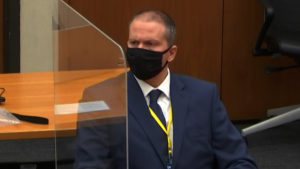Observations of the Trial of Derek Chauvin
The second week of the trial of Officer Derek Chauvin has concluded, and the latest witness testimony centered around the autopsy findings of Mr. George Floyd. Chauvin has been charged with the murder and manslaughter of George Floyd after pinning him to the pavement by a knee to the neck for more than nine minutes following the arrest of Mr. Floyd for possibly passing off a counterfeit $20 bill at a local store in Minneapolis, MN on March 25, 2020. The entire incident was captured on video which has been viewed around the globe, thus sparking international Black Lives Matter protests which shined a spotlight upon police brutality against Black people.
The Prosecution has thus far interviewed police officials including Minneapolis Police Officer Nicole Mackenzie who coordinates medical response, Los Angeles Police Department Sgt. Jody Stiger who is an expert on use-of-force, Chief of the Minneapolis Police Department Medaria Arradondo who testified that the use of force by Chauvin was not in compliance with department policy. They also presented expert medical testimony of Dr. Martin Tobin, a renowned pulmonary specialist and critical care specialist. He testified that Mr. Floyd died due to hypoxia or asphyxia, likely due to compression of Chavin’s knee to Mr. Floyd’s neck. He specified that the effects that drugs present in toxicology reports were inconsistent with the physiological findings seen on video thus could not be the cause of Mr. Floyd’s death, and explicitly stated that the actions of Chavin and his fellow officers on the scene directly led to Mr. Floyd’s death. According to Huffington Post: “Dr. Andrew Baker, Hennepin County’s chief medical examiner, wrote on Floyd’s death certificate that he died from ‘cardiopulmonary arrest complicating law enforcement subdual, restraint and neck compression.’ His manner of death is listed as homicide, which, to medical examiners, describes a death that occurs at the hands of another person who may or may not have intended to kill.” Segments of the video entered into evidence played along with related testimony given by the witnesses. Mr. Floyd’s long-term girlfriend testified about their difficulties with addiction, and gave testimony regarding obstacles he faced in his personal life including the death of his mother and job loss due to the coronavirus pandemic. Prosecutors also interviewed the witnesses at the scene who all displayed a sense of deep sorrow for not being able to further assist Mr. Floyd to spare his life.
The Defense cross-examined all prosecution witnesses, having theories contradicting the testimony. The Defense has used testimony to present a picture that the witnesses were angry or emotional which affected Chauvin’s ability to carry out his duties properly during the arrest. Also, they hope to make the jury believe that Mr. Floyd’s addiction and the drugs in his system presented in medical evidence were the contributing, if only, factor that caused his death. Furthermore, they attempted to get the police official witnesses to testify that Chauvin’s technique of using the knee to the neck to hold or control a subject were within police department norms. Additionally, the Defense theorized what was observed on video, particularly with the position of Chauvin’s knee and Mr. Floyd’s body could be interpreted differently than described by the witnesses. The also asked specific questions to the medical examiner and medical experts to contradict the manner of death as stated on the death certificate.
There is concern that replaying of clips of the video, particularly by the Defense, could desensitize the jury to what they are witnessing. The jury consists of one Black woman, two multiracial women, three White men, three Black men and six White women (12 jurors and three alternates). Personally, each time the clip is played, I feel the same sinking feeling in the pit of my stomach and sadness for the victim who is MR. FLOYD and Mr. Floyd’s family as the first time I saw the video. The video is difficult and distressing to watch, and viewers may empathize with the witnesses on the scene who likely have the images seared into their memory. The trial overall is hard to watch, but there is no doubting the historical significance of the trial, particularly as it relates to police brutality and changes to policing. Most police officers are acquitted in similar circumstances, if they face legal consequences at all. According to FiveThirtyEight: “Stinson’s Henry A. Wallace Police Crime Database is among the best sources available on prosecutions of police; it logs 10,287 criminal arrest cases between 2005 and 2014 involving 8,495 non-federal sworn law enforcement officers…Stinson has found only 110 law enforcement officers nationwide have been charged with murder or manslaughter in an on-duty shooting — despite the fact that around around 1,000 people are fatally shot by police annually, according to a database maintained by The Washington Post. Furthermore, only 42 officers were convicted. Fifty were not and 18 cases are still pending…many of these convictions ended up being for a lesser offense — only five of these officers were convicted of murder (and did not have that conviction overturned).”
The consequences of the outcome of this trial cannot be stressed enough. Knowing the depths of sorrow and outrage expressed by people throughout the globe in response to Mr. Floyd’s wrongful death are in indication of what could be demonstrated in response to a possible acquittal for Chauvin. The jury has a large responsibility to shoulder, especially knowing that the trial is televised and the public is witnessing the testimony in real-time. Let us hope that the jury throughly examines and discusses the testimony presented prior to coming to a final conclusion. There should be no hedging or whataboutism which is prevalent on social media by defenders of Officer Chauvin. Even if the jury cannot agree on a verdict and cause a mistrial, the global response will be staggering and disbelief will be the last thing people will express.
[si-contact-form form=’2′]


